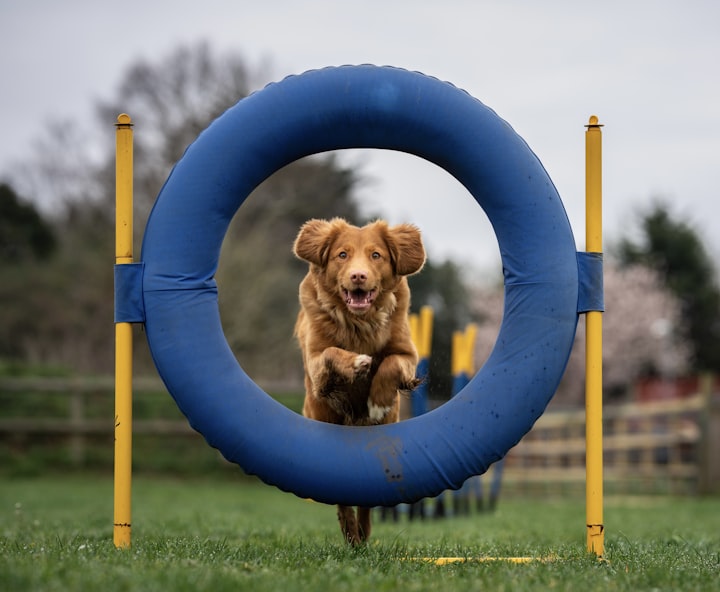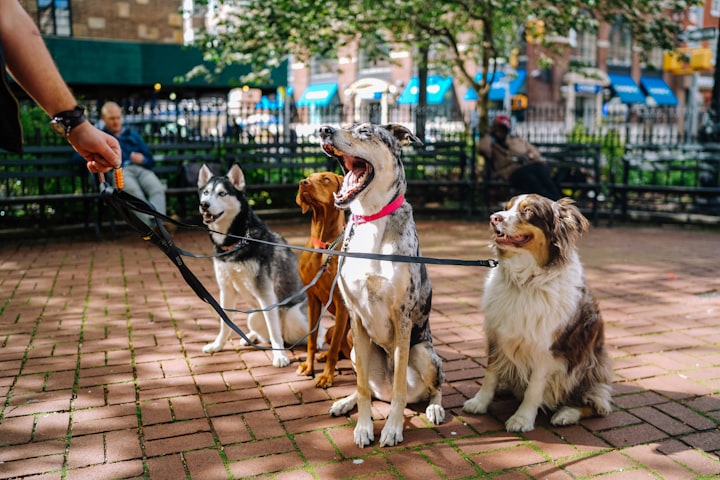How To Completely Train Your Dog
Are you prepared to begin teaching your puppy or dog? Your dog's basic needs include proper training and socializing. It's critical to get your dog started on training as soon as possible.
Dog training might be intimidating at first, especially if this is your first dog. The truth is that training your dog is a significant undertaking. You will find the work to be considerably less overwhelming if you approach it step by step. To get you started, here's some information:
Start a Dog Obedience Program: Before you start training your dog, learn how to lay a solid foundation.
Are you prepared to begin dog training? A good dog training program is the foundation of good dog behavior. There are no terrible dogs, only uneducated owners, as the saying goes. Boundaries and consistent routines are beneficial to most dogs. They just do not know how to behave without obedience instruction. Dogs who have been properly trained, as well as their owners, are happier and healthier.
There are numerous methods for training your dog. You can enroll your dog in a dog training class, engage a professional dog trainer for private lessons, or send your dog to a trainer's boarding facility. Many people, on the other hand, effectively train their dogs on their own. It's a fantastic way to save money on training while also bonding with your dog.
It's critical to have a plan in place before you begin training your dog. You'll need to gather some equipment, create a schedule, and master some basic training techniques. You must also be fully committed and ready to commit on a daily basis. Here's everything you'll need to start your own dog obedience training program.
Equipment
Although efficient dog training does not necessitate a large number of products, there are a few essentials that will make the process more convenient and productive. Choose a dog collar or harness that is appropriate for your dog and comfy for him. Then select on the best dog leash for training. Dog training should not be done with a retractable leash. You'll also need dog training goodies that your dog appreciates and can eat quickly so the reward is received sooner. There are many fantastic treats available at pet stores, or you may create your own, such as little bits of plain cooked chicken or turkey.
Choose a Method
Choose the finest strategy for you and your dog before you start dog obedience training. Although training methods differ, most trainers believe that positive reinforcement, such as praise or rewards, works best for dogs. The use of conditioned reinforcers is a frequent training modification known as clicker training. There are numerous dog training books and websites available where you may learn about different training methods and decide which one is best for you and your dog. Don't forget to include socialization in your training tactics.
Set up Sessions
Small steps are frequently taken to achieve success. Two to three times a day, 10 to 15 minute training sessions with your dog are recommended. Because puppies have such short attention spans, this is especially true. Adult dogs may become bored with longer sessions. Begin by teaching the most basic commands. To avoid your dog being confused, try to limit yourself to one action per training session.
Basic Commands
The sit command is usually one of the first commands your dog learns. You can then teach your dog to lie down. Work on training your dog to stay at the same time. In addition, your dog should be trained to respond as quickly as possible when called. One of the most significant fundamental directives is this one. You can go to exciting tricks and advanced commands once your dog has learned these dog obedience basics.
Get Help
Seeking expert assistance does not imply that you should abandon your DIY training program. A professional dog trainer who offers private training sessions can be found, and some trainers even offer internet training sessions. Many dog owners prefer to enroll in a local dog obedience class so that they can be supervised by a dog trainer without having to pay for private lessons. Plus, classes force your dog to learn in the presence of other dogs, which can be distracting.
Dog training classes or private sessions can be an excellent complement to your personal training routine. The dog trainer can assist you in improving the program and tailoring it to the learning style of your dog. When it comes to your dog's training, try to be as hands-on as possible. When you are personally involved in the training process, you and your dog will become a stronger team.
Problems and Proofing Behaviour
Dog training takes time, and you and your dog are bound to have some setbacks. You may encounter some opposition or obstinacy. Keep things pleasant by rewarding your dog for good behaviour, and make sure the incentive is something your dog is willing to work for.
You may also observe common dog behaviour issues such as jumping up, barking, or even hostility in your dog. Interrupting misbehavior is the most effective way to remedy it. Change your dog's focus to something more positive. Try going over a list of indications that your dog understands, followed by treats. Maintain a calm and confident demeanor, and be clear about what you mean.
The key to success is positive reinforcement. Punishing or becoming angry at your dog during training is a common mistake. This will simply add to the chaos. You can try to keep your dog's attention with rewards and enthusiasm, but when your dog grows bored or sleepy, it's time to end the session. Make an effort to end each session on a positive note. Patience and consistency will eventually lead to successful training.
Games to Train Your Dog: Training your dog should be enjoyable! Everyone knows that learning is easier when you're having fun, so include some games in your dog training routine.
Dogs only want to have a good time! While all dogs require serious training, fun is as crucial. Games can be used into training as well, but sometimes it's simply about having fun.
Playtime gives exercise and mental stimulation for your dog. It's also a great method for you and your dog to bond. Boredom and the behavioral concerns that come with it can be avoided by playing games with your dog.
Some games are suitable for indoor play, while others necessitate the use of outside area. There are a lot of fun things for kids and dogs to do together. These games can also be used to educate your dog how to play. Of course, prior to playing these activities, your dog should be familiar with some fundamental commands.
Check out some entertaining dog games that will keep your dog occupied and interested on a daily basis.
01 Fetch

Many dogs have an innate desire to retrieve objects. Other dogs can be taught to do the same. Fetch is a game that may be played practically anyplace. Play with a soft toy indoors or with a ball or disc outside in a fenced-in area. Try the ChuckIt! Ball Launcher for dogs who love to run (and to avoid slobbery hands). They even have a gentler version for usage indoors.
02 Tug-of-War

A good game of tug-of-war is enjoyed by many dogs. It allows them to release their pent-up energies and inherent predatory instincts. It can also exhaust them. To play tug-of-war safely, make sure your dog understands the release command. Then, grab a strong, solid tug toy and start tugging. Allow your dog to win on occasion, as this will increase his confidence.
03 Hide and Seek

It's not simply for youngsters to play hide and seek. This is a game that dogs will love. It's also a fun method to work on your recall skills.
Tell your dog to stay first. Then go find a suitable hiding spot with one of your dog's favorite toys, chews, or goodies. Call your dog to come to you when you're ready. To get your dog to come to you, squeak the toy or shake the treats. Once your dog has located you, praise him enthusiastically and give him the toy or treat you are carrying.
04 Find the Treat

Dogs have excellent senses of smell, and they like using their noses to discover new things. Allow your dog to use her intellect and nose to sniff out hidden treats.
To begin, keep your dog out of sight (or put her in another room or a crate). Then, at various locations throughout the room, hide her favorite snacks. Return your dog to the house and instruct her to "go find!" If you need assistance, you can use a leash to guide her around or point to spots for her to explore.
05 Interactive Treat Games
On the market, there are a range of entertaining interactive dog toys that demand some problem-solving. Many pet supply stores sell dog treat dispensers and dog puzzles of various levels of complexity. You may also create your own by drilling holes in a water bottle or other plastic container at home. Fill the toys with delicious smelling goodies and challenge your dog to find out how to get them out. This stimulates your dog's brain and sense of smell, satiating his natural hunting urge.
06 Dog Sports

Is your dog a high-energy creature? Super-intelligent, yet a "troublemaker"? Maybe she just needs a new pastime. If regular exercise and activities aren't enough to meet your dog's demands, dog sports could be the answer. Participating in a canine sport is a terrific way to keep your dog entertained on a regular basis. Discover the many different sorts of dog sports available and see which ones would be best for your dog.
First and foremost, there is safety.
When you're playing with your dog, keep an eye out for indications of tiredness or overheating. If your dog appears exhausted, irritated, or agitated or anxious, come to a halt. When playing with your dog, be cautious of your surroundings. When there are other dogs or people nearby, especially if your dog is off-leash, it can be a dangerous distraction. Have a good time, but be safe!
Six Weeks to a Well-Trained Dog: You can teach your dog the basics in approximately six weeks using this plan as a guide.
All dogs require proper training, and it does not have to be difficult or costly. It's never too early to begin teaching your dog, whether you have a new puppy or an adult dog in your house. The structure and confidence that comes with training make most dogs happy.
When you first start working on dog training, it might feel daunting. Develop a week-by-week timetable to assist you become organized if you're not sure where to start. Choose one or two fundamental commands to practice on each week. Plan to make some changes to your dog's surroundings to prevent or correct behavioural issues.
Incorporate a Crate
If you haven't used a crate before, the first week of training is an excellent time to start. When you aren't there to oversee your dog, the kennel is a useful tool for controlling his behavior. Allow your dog to become accustomed to the crate by allowing it to sit in it for a few minutes at a time each day this week. It's possible that your dog will ultimately choose to sleep in its crate.
Begin to leave the dog in its crate for extended amounts of time, but not more than a few hours at a time. Make sure to include some entertaining and educational items. Throughout your dog's training, continue to use the crate. The majority of dogs appreciate having their own personal space. Because most dogs will not defecate or urinate where they sleep, crates can aid in housetraining.
Create a Schedule
Routine is really important to dogs. Early on in your training, make a timetable for mealtimes, walks, and playtime. Maintain consistency on both weekdays and weekends from the first week of establishing the program. If your dog will be cared for by a dog walker or someone else, make sure they are aware of the schedule as well. During and after the dog's training, stick to the program as strictly as possible. This will assist your dog understand what to anticipate and when to expect it. It's also helpful for housetraining since your dog will learn when it's okay to go outdoors (ex: after every meal, the dog gets walked to relieve itself).
Obtain Some Toys
Decide how you'd want to reward your dog. Although clicker training is beneficial, incentives can also be used instead of the clicker. Before you start teaching your dog orders and tricks, give him a range of toys to play with. Include some mentally stimulating items, such as Kong toys or Buster Cubes. This will keep your dog cognitively stimulated, which is vital given that most owners are unable to play with their dogs throughout the day. Don't hand out all of your dog's toys at once. Introduce toys this week, and then rotate the different toys each week throughout the process so that your dog is constantly playing with something fresh and exciting.
Educate Your Dog on Commands
In order to teach a dog, you must first learn the commands. To be secure, your dog must understand how to respond to its owner. Begin with the most basic instructions and work your way up to more complex ones.
- Sit: Make an effort to teach your dog to sit. Spend around five minutes a day for the next week practicing the "sit" command.
- Next, spend a few minutes each day practicing on the down command and teaching your dog how to do an emergency recall.
- Come and Leave It: Once your dog has learned the commands "sit" and "down," you may progress to these more difficult commands.
- Stop jumping: You may either set aside time each day to practice this habit or wait until it arises naturally in your daily activities (for example, when your dog leaps up to meet visitors at the door) to work on it.
- You may either practice this in regular training sessions or wait for opportunities to present themselves throughout the day. Before taking your dog outside or letting him out of his kennel, make sure he waits.
- Begin focusing on teaching your dog to go to a specific location in your home and lie down. When you're watching TV or reading a book, mealtimes are ideal times to practice having your dog sleep peacefully in position.
- Drop it: Teach your dog the "drop it" command in multiple brief training sessions each day.
- Stop barking: Work on the "talk" and "quiet" commands to teach your dog to be quiet. You may either do this during training sessions or wait till your dog barks and utilize it as a practice chance.
Taking a Walk on a Leash
Begin training your dog to walk on a leash that is not too tight. This will educate your dog how to walk safely, which will benefit both the dog and the walker. To perfect this ability, take at least one short stroll each day this week. This is a skill that you should keep practicing throughout your education.
Pick a Trick
After working on walks and teaching your dog a few basic instructions, you may focus on teaching it tricks and more complex commands over the week. This might include amusing tricks like "turn over" or "play dead," or the "heel" command to give your dog a bit more control on walks if he already knows how to walk on a free leash. Tricks aren't required, but they may be entertaining for your dog and help them gain recognition for excellent conduct.
Problems and Proofreading Techniques
After a week of working on one approach, your dog should be able to react to a variety of orders. This does not imply that you have completed your training. Training must be repeated and reinforced throughout the course of your dog's life to "prove" the behavior. Your dog will be a happy and well-adjusted part of your family as a result of the training.
Make it a point to revisit the instructions and actions you've previously learned three times a week for a total of 10 minutes. It's always a good idea to review commands you've taught to make sure they're being followed.
If you're experiencing problems with the training or a specific phase, enrolling in a training class (typically with other dogs) or seeing a canine behavioral specialist may be beneficial. They can set up one-on-one (and maybe group) sessions with you and your dog to get to the base of the training challenges and devise long-term solutions.
House Training and Crate Training
You'll need to educate your dog where to eliminate unless you want to keep him outside, which few of us do because it's not suggested. As a result, one of the first things you should concentrate on with your dog is house training (also known as housebreaking or toilet training). Crate training may be a highly beneficial component of your dog's training. This involves both house training and a variety of different types of training:
- Dogs and Puppies Cage Training: Here are the fundamentals of teaching your dog or puppy to tolerate and even like their crate. It will not only assist with housebreaking, but it will also provide your dog with his own space.
- When it comes down to it, house training your dog isn't all that difficult, but that doesn't mean it's simple. During the housebreaking process, consistency and diligence are essential.
- Submissive/Excitement Urination in Dogs: If your dog is still having accidents in the home, it might be something more serious than a simple housebreaking problem. Urinate to convey submissive conduct or to exhibit enthusiasm in your dog.
Dogs and Puppies on a Leash
Every dog should be taught to walk on a leash. Aside from the fact that leash restrictions exist in most locations, there will be situations when keeping your dog on a leash is necessary for his protection. Learn how to introduce your dog or puppy to the leash, then show him how to walk on it properly, even while riding a bike behind you. Walking on a loose leash teaches your dog not to pull or lunge when on the leash, making the experience more pleasurable for both you and your dog.
How to Socialize Puppies and Dogs
By introducing your puppy or adult dog to different people, animals, and environments, you may teach him to tolerate new people, creatures, and places. Dogs who have been socialized are less prone to develop behavioral issues and are typically more well-liked by their peers. Socialization can also aid in the prevention of phobias and anxieties.
In the end, socializing your dog or puppy will result in a happier, better-behaved canine.
Dogs' Clicker Training
Clicker training is a simple and successful dog training approach that uses positive reinforcement. Although you may train your dog without using a clicker, many people find it beneficial. You can quickly and efficiently teach your dog all types of basic and advanced instructions and tricks with clicker training. Learning how to clicker train your dog is simple and quick.
Basic Instructions and Tricks
Every dog should know some fundamental dog training commands and skills, such as come, speak, drop it, stay, back up, and so on. Basic commands provide structure for your dog. They may also assist you in overcoming typical dog behavior issues and keeping your dog safe.
What could be more entertaining than showing off your dog's impressive skills? Dog tricks are a fantastic method to take your dog's training to the next level while also providing mental stimulation for your dog.
Troubleshooting and Proofing Behaviors
Proofing is the final stage in teaching your dog a new trick. Learn how to prove behaviors so that your dog is as obedient in the park or at a friend's house as he is at home.
Remember that just because you've reached the end of your training doesn't mean you won't run across behavioral issues. Discover the most frequent dog behavior issues and how to handle them. These guidelines will assist you in navigating this stage of the training:
- Proofing Behaviors: Put your skills to the test in a variety of circumstances with varying degrees of distraction. If you don't proof your dog, he may behave beautifully in your living room but seem to forget all he's learned when he's outside.
- Teach Your Dog Self-Control: This strategy teaches your dog that nothing in life comes for free, and that food and attention must be earned via obedience.
- Common Dog Behavior Issues: Recognizing and addressing possible behavioral issues might help you catch them before they spiral out of hand.
- Dog Behavior Management vs. Dog Training: While these two concepts are distinct, they are not mutually exclusive. Any dog training program should include behavior control.
Training for Advanced Dogs
After your dog has learned the fundamentals, you may go on to more sophisticated tricks. These exercises will keep your dog fit, active, and cognitively occupied. Additionally, they will aid in the strengthening of your relationship with your canine partner.
Keep in mind that training is a continuous process. There will never be a day when you are entirely completed. It is critical to continue working on your dog's obedience training throughout his or her life. People who learn a language at an early age but don't use it may forget a lot of it as they become older. It's the same with your dog: if you don't use it, you'll lose it. Even the most basic tricks and commands may be practiced to keep them fresh in your dog's mind. It's also a terrific way to bond with your dog.
About the Creator
FN Pet
Hello welcome,
I am an expert in pet care.I will be posting article s about pets here. I will give you special information you need to know about pets, such as how to care for pets, how to train them etc.







Comments
There are no comments for this story
Be the first to respond and start the conversation.